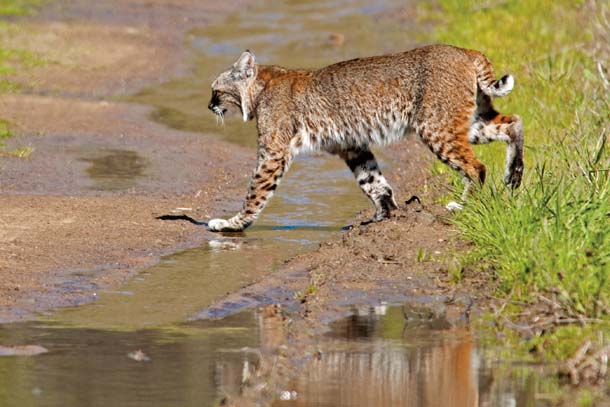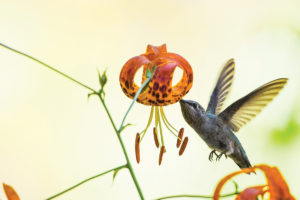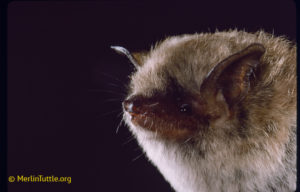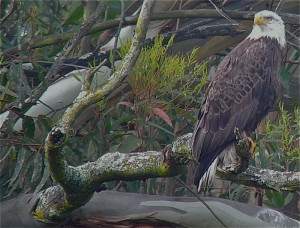The waning gibbous moon looked like a bright thumbprint stamped on the morning sky as I walked along a frosty stretch of trail in Morgan Territory Regional Preserve, in the hills just north of Livermore. Veteran East Bay Regional Park District Naturalist Cat Taylor had agreed to help me learn to identify tracks and signs left by wildlife. We were going to look for the prints, scat, and other markings of creatures who generally keep out of sight — gray fox, bobcats, and wood rats, to name a few.
I’ve always been enchanted by the idea of animal tracking, but daunted by how much I would need to know to do it myself. According to Taylor, who has been studying animal prints and signs for as long as she can remember and teaching them to the public for more than 22 years, tracking is like learning to read nature’s newspaper. And once you can pick out a few words, a whole narrative begins to unfold.
That morning, surrounded by mature coast live oaks and a velveteen fuzz of green shoots spurred by recent heavy rains, Taylor moved carefully, straddling the thin, muddy trail to preserve a string of deer tracks. Each print looked like an inverted heart cracked open down the middle, and they extended in a staggered line for 15 feet. She asked me whether we were looking at the markings of a doe or a buck. I raised a single brow in her direction — I’d been rather pleased that I knew it was a deer.
“Think of how females are built versus males,” she said. “Males have broad shoulders and narrow hips. Females have narrower shoulders and wider hips.” She bent over to demonstrate how a female deer with narrow shoulders walking on four feet would put down her front foot and then with her wider hips naturally place her back foot further to the side when walking. Taylor straightened herself and continued, “Now, if you were a buck, with the big shoulders and narrow hips, you put your front foot down and your back foot would go inside.” Since the back feet of ungulates tend to be smaller than the front, it wasn’t hard to determine which foot made which print. When I reexamined the trail, it now seemed obvious that we were looking at the tracks of a buck.

“The other really cool thing to look for is size and whether one track is directly on top of the other,” Taylor said. If the tracks are small and right on top of each other, then a young deer may not have matured enough to display male or female characteristics. Does about to give birth are also easy to pick out, she continued. “Her front feet will point forward and her back feet will start to angle outwards because she’s waddling from carrying one or two fawns.” I asked whether this was true for all animals and Taylor said she’d only seen it in hoofed animals. “It seems like hocus-pocus and magic,” she said, as I expressed my delight with these new insights, “but really it’s not when you stop to think that they’re not too different from us. It’s a lot of fun to read the story.”
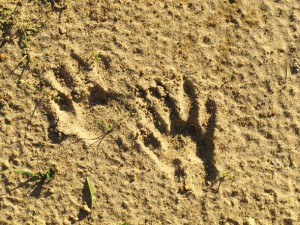
Our human story has hinged — more than we might think — on our ability to decipher these tracks and signs of the species around us: When your survival depends on finding and capturing food, reading animal tracks is much more than a hobby. While tracking is still an important part of survival for some, it has also become an indispensible tool for scientists and is increasingly a way for the rest of us to strengthen our connection to the natural world. For decades, East Bay Regional Park District naturalists have taught tracking classes to people of all ages. Tracking and the ability to trail and find animals have also been fundamental to wildlife surveys in the regional parks.
Taylor’s tracking experience spans both education and science. Today, she runs school programs for the parks that incorporate aspects of what naturalists call “tracks and signs,” but earlier in her career, at Shenandoah National Park in Virginia, she helped out with research work by trailing black bears and analyzing bobcat scat.
That particular expertise came in handy when we passed a small pile of grayish droppings just off the trail. Taylor slipped on latex gloves and picked up a two-inch-long piece of what to me resembled molded felt. She broke it open and pointed out squirrel hairs and a tiny piece of bone. From this, she judged that the animal had feasted on a ground squirrel and not much else — a telltale sign of a cat. She then pointed to a series of scrapes — the superficial troughs left by an animal kicking its back feet — radiating from the scat. “I’m 90 percent sure this is bobcat,” she said with a smile. “This is our find of the morning.”
I asked Taylor to explain the difference between identifying tracks and signs, as we had been doing that morning, and actually trailing an animal to find it. “When I’m tracking, I’m on my hands and knees a lot and taking measurements of the track dimension, stride length. If there’s a stretch of tracks, I might mark the front and back feet with different colors of checkers so that I can glance along the trail and identify whether the animal is walking, trotting, stalking, or bounding. It’s very intense and focused right here,” she said, pointing to the ground. By comparison, when she’s trailing, her focus is outward. “Your awareness is about ten feet ahead of you. You find a good fresh trail and then you try to figure out which way it’s heading, and you’re looking for other cues.” Screeching and stamping squirrels are a good indicator that a threat is moving into their territory; a flock of birds that suddenly takes flight could mean the same thing. “You’re very aware of everything that’s going on while making sure you’re still on the trail of that animal.”
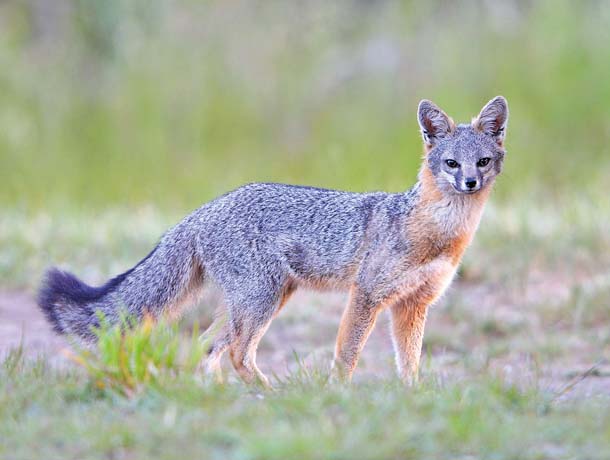
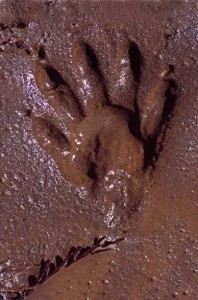
Those sorts of traditional tracking and trailing skills have long played, and will continue to play, a role in park district wildlife research, says Steven Bobzien, an ecologist with the district. He recalls efforts to determine the density of San Joaquin kit foxes in the parks in the 1990s by setting out soot track plates. The technique is a little like fingerprinting an animal. The critter walks over an aluminum plate covered in soot and then onto a strip of sticky contact paper, leaving its blacked prints for identification. But even that technology appears antiquated now in the face of new wildlife documentation techniques, such as remote cameras, thermal imaging technology, and night vision scopes.
Nonetheless, good old-fashioned tracking will play a meaningful role in the new East Bay Puma Project. Ecologists led by the Felidae Conservation Fund hope to radio-collar pumas in the region this year. To get collars on the cats, researchers will need to track, capture, and tranquilize them. Once the collared cats are released, the researchers hope to monitor the density of pumas in the region, document their response to encroaching urbanization, and identify important corridors the animals use to move between habitats.
“Tracks and signs are still fundamental to knowing what’s on the landscape,” Bobzien says. “The first thing we’re doing with the puma project is looking for puma tracks or signs.” On a day-to-day basis he relies on the identification of prints, scat, scrapes, and hair left by the cats to check the veracity of sightings reported by the public.
Some of those reports come from park district trail patrol volunteers who regularly hike, bike, and horseback-ride the 1,150 miles of trails within the district’s 65 parks. Taylor has trained some of the volunteers in basic tracking and will focus on puma ecology, track, and signs with them this year. Using their new skills, the volunteers will help document the presence of pumas in the parks even without seeing live cats.

Most of Taylor’s job, and that of her two dozen fellow district naturalists, involves getting kids excited about nature in the parks. For some kids, visits through school programs are the only times they experience unmanicured nature.
Anthony Fisher, a naturalist at Tilden Park, says tracks are an “opportunity for the kids to focus and start to see what’s around them.” He will often ask the kids to check out a track during their walk together and will begin with a simple question like how many toes do you see? “They’ll yell out ‘eight!’ ‘15!’ or something random,” Fisher says, “and that’s when I can get them to stop and count and really look.” Scat is also, of course, a good attention grabber for kids.
Fisher tries to supply kids and adults alike with different approaches for interacting with nature and wildlife. “One way people have traditionally engaged with nature is through collections of all sorts of specimens, including bird eggs, insects, and even scat. But that’s not necessarily a good thing, and you’re not allowed to take anything out of the park.” To give people alternative items to collect, Fisher offers classes on creating plaster impressions of tracks and using soot boxes, like the researchers do. “You can scan the soot track onto your computer and examine it at a very detailed level,” Fisher explains. He also experiments with remote video cameras and has gathered footage of many kinds of wildlife in the park, from mischievous raccoons and industrious dusky-footed wood rats to curious gray foxes and hungry coyotes.
Another way Fisher helps people learn to track is by having them examine the marks they themselves leave behind. I was walking with Fisher along a soggy fire road one morning in Tilden Park when he demonstrated the difference between his shoe-print while walking, running, or walking while beginning to turn. “A track can also tell you a lot about what an animal is doing.” The running print left a deep, elongated impression that lacked the detail of the walking track, while the turning print showed dirt pushing up in the direction opposite to the pivot. “You can practice this in a wet sandbox or at the beach,” he says. Other good learning terrain includes areas with fine dust and open spaces where a set of tracks can continue for a long way. Those are particularly good opportunities for studying the gait of an animal — how the placement of the four feet changes depending on how fast the animal is moving. As we walked, I jokingly pointed to a circular, dime-size hole in the mud: “This could be the rare track of an elusive human walking with a trekking pole.”
Fisher grinned and asked, “Which way was the person going?”
We knelt down to examine the hole, and the more I looked the less circular and more ellipse-shaped it appeared, with soil pushed down on one side and kicked up slightly on the other. I felt like I was back in high school physics trying to imagine the force exerted by a body in motion and the physical traces it would leave. We deduced we were hot on the heels of the hiker.
“It’s a lot like being a detective,” Fisher says, but getting good at the investigative work requires what many trackers call dirt time. “You just have to spend time doing it. A teacher can tell you things, but ultimately you have to teach yourself — and have the desire to learn.”
Many people who have become adept trackers, including Taylor and Fisher, will quickly point to two titans in the field as sources of inspiration and information. A Ph.D. candidate in ecology at the University of California–Davis, Mark Elbroch has churned out a stack of definitive scientific tomes and field guides on tracking and animal skulls. Tracker and spiritualist Tom Brown has been writing books on the subject for more than 30 years and runs a New Jersey wilderness survival school that has introduced tens of thousands of people to tracking.
Among them was Ch’ien Lee, who grew up collecting bugs in Tilden Park under the guidance of former district naturalist Alan Kaplan. Lee’s early dreams of becoming an entomologist were forever changed in the late 1980s after he read Tom Brown’s now seminal book The Tracker. “What touched me the most was the intimacy with nature, and how you can really glean so much information,” Lee says. “Most of us pass by so much on a hike, but if you get down in the dirt, there’s so much there. You can spend hours on one patch of ground and lose yourself. I really identified with that.”
At the suggestion of his neighbor, now-retired Tilden naturalist Tim Gordon, Lee became an interpretive student aide at Tilden Park after he graduated from high school. When he advanced to naturalist’s aide, he started a group called the Tilden Trackers, leading monthly hikes and teaching people how to make casts of tracks and use soot boxes. Since then, his method of choice for studying nature has shifted from tracking to photography. Today he lives in Borneo and has traveled all over the world working as a photographer and guide. “But for me it’s never just been about the photographs,” Lee says, “It’s more about being outside examining and enjoying nature.”
That’s what it’s about for me too, I realized. I didn’t need to know everything about tracking to get started — I just needed to start. So I decided to build a soot box and set it out in my Berkeley hills backyard. Lacking the kerosene lamp or acetylene torch that most trackers use to soot the plates in their track boxes, I got out some partially burned Christmas candles and began blackening a rectangular sheet of aluminum. I laid a strip of contact paper in the middle of the plate, covered it with a small aluminum hood to protect the delicate soot from the elements, and set it in a quiet part of the backyard.
About 48 hours later I went to investigate the box, only to find that the hood had blown off and the contact paper was covered in a fine spray of soot. Flustered, I reassembled the cover and figured I just needed more time. I began checking quickly before heading to work every morning, but there were no new signs of activity, so I decided I should resoot. However, as I removed the contact paper, I noticed what looked like a smudge. And there was another. And clearly that smudge consisted of four dots hovering above a fifth. Could it be . . . ?
Hurrying inside, I placed the contact paper under a bright light and pulled out my ruler and tracking guide. I turned to the section on squirrels, since I had recently seen some in the yard. But the four smudges formed a spade shape, not at all like a squirrel, whose middle toes are roughly the same length. I flipped through track pictures and spotted the gray fox — the toes fell in an arch and the size seemed about right, although small. Several months ago, I had seen a little pile of scat sitting on our rock wall. Based on tips from Taylor, it seemed plausible that it might have been fox poop. Could these be the footprints of a gray fox? Or was it our new puppy?
Clearly, I would need more information to make the distinction, so I dug out the Christmas candles and started sooting my aluminum plate again, strategizing where to place my box next.
Victoria Schlesinger is an environment and science journalist whose work has been published by numerous outlets, including Harper’s Magazine, Audubon, and the New York Times. She’s also the author of Animals and Plants of the Ancient Maya, published by University of Texas Press.

